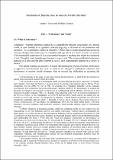Files in this item
Standards of (in)coherence in ancient Jewish literature
Item metadata
| dc.contributor.author | Teeter, David Andrew | |
| dc.contributor.author | Tooman, William | |
| dc.date.accessioned | 2021-07-26T23:35:14Z | |
| dc.date.available | 2021-07-26T23:35:14Z | |
| dc.date.issued | 2020-07-27 | |
| dc.identifier | 257990749 | |
| dc.identifier | 46831477-ef14-4ba7-ac45-9aa8b9329377 | |
| dc.identifier | 000565684500002 | |
| dc.identifier.citation | Teeter , D A & Tooman , W 2020 , ' Standards of (in)coherence in ancient Jewish literature ' , Hebrew Bible and Ancient Israel , vol. 9 , no. 2 , pp. 94-129 . https://doi.org/10.1628/hebai-2020-0009 | en |
| dc.identifier.issn | 2192-2276 | |
| dc.identifier.other | ORCID: /0000-0001-6989-8267/work/78528483 | |
| dc.identifier.uri | https://hdl.handle.net/10023/23641 | |
| dc.description.abstract | In this article, we sketch an anatomy of issues and decisions that must be navigated in any attempt to understand coherence and incoherence in ancient Jewish literature, including: the meaning of »coherence,« its relationship to »unity,« the suitability of modern standards of (in)coherence to ancient texts, and the availability of ancient standards of (in)coherence. We argue that modern perspectival representation and modern standards of literary (in)coherence are not necessarily appropriate to ancient Jewish literature, and we propose that these issues can only be properly approached after undertaking an inductive, comprehensive analysis of the ancient Jewish literature itself, in effect, learning the »ways of the text.« | |
| dc.format.extent | 36 | |
| dc.format.extent | 408313 | |
| dc.language.iso | eng | |
| dc.relation.ispartof | Hebrew Bible and Ancient Israel | en |
| dc.subject | Coherence | en |
| dc.subject | Incoherence | en |
| dc.subject | Ancient Jewish literature | en |
| dc.subject | Egyptian art | en |
| dc.subject | Modern art | en |
| dc.subject | Cohesion | en |
| dc.subject | Text linguistics | en |
| dc.subject | Hermeneutics | en |
| dc.subject | Empirical models | en |
| dc.subject | Biblical criticism | en |
| dc.subject | Historical criticism | en |
| dc.subject | Literary criticism | en |
| dc.subject | Literary approach | en |
| dc.subject | Unity | en |
| dc.subject | Literary unity | en |
| dc.subject | D051 Ancient History | en |
| dc.subject | T-NDAS | en |
| dc.subject | BDC | en |
| dc.subject | R2C | en |
| dc.subject | ~DC~ | en |
| dc.subject.lcc | D051 | en |
| dc.title | Standards of (in)coherence in ancient Jewish literature | en |
| dc.type | Journal article | en |
| dc.contributor.institution | University of St Andrews. School of Divinity | en |
| dc.identifier.doi | 10.1628/hebai-2020-0009 | |
| dc.description.status | Peer reviewed | en |
| dc.date.embargoedUntil | 2021-07-27 |
This item appears in the following Collection(s)
Items in the St Andrews Research Repository are protected by copyright, with all rights reserved, unless otherwise indicated.

